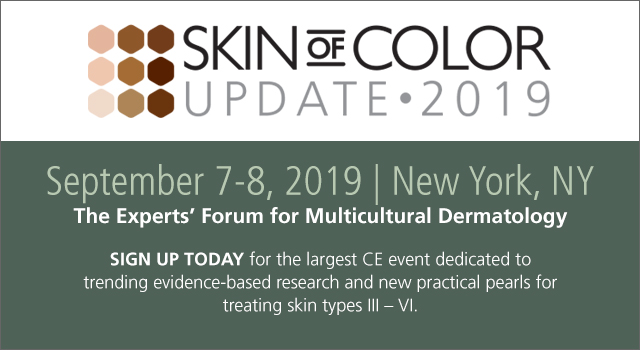As one would expect, Dr. Ted Rosen’s session on Sexually Transmitted Diseases (STDs) in Skin of Color was engaging, informative, and shocking to many in the audience. During this 20-minute session, Dr. Rosen addressed the increasing rates of STDs in the United States and highlighted the alarming predominance in non-white ethnic groups. *Clinical pearls* from this session are bolded, underlined, and marked with asterisks.
The title of this session sums up the take-home message – *we are in a CRISIS STATE in the United States with respect to STDs, particularly in skin of color populations.*The STD data from 2017 is worse than 2016, which was worse than 2015, and so on. *Every year, 20×106new STDs are diagnosed!*Over 50% of Americans will contract an STD during their lifetime, often before the age of 25. Teenagers are at high risk as well, with 1 in 4 teenagers developing an STD. First piece of good news: *Sex in high school is decreasing*in the US, with the exception of a few states(from east to west): North Carolina, Michigan, North Dakota, Wyoming, and Arizona. Perhaps this will correlate with decreased STD transmission among teenagers in the coming years.
As most of us know, HIV is predominately seen in men who have sex with men (MSM). HIV started in white MSM (and these individuals are now under treatment and living), but the demographics of HIV have shifted. *Although the majority of MSM living with HIV are white (40%), a disproportionate number of newly diagnosed HIV infections are in Black (38.1%) and Hispanic (28.6%) individuals.*Young black and Hispanic MSM ages 13-24 years are at particularly high risk, with 54% and 25% of new cases diagnosed in these ethnic groups, respectively. Therefore, Dr. Rosen suggests that providers suspect HIV/AIDS in a young, black male with cutaneous signs and symptoms of retroviral infection, including seborrheic dermatitis, psoriasis (with negative family history), herpes zoster, moniliasis, bad warts, and lymphadenopathy.
The surge in gonorrhea cases in skin of color populations is similarly alarming. *Gonorrhea cases have increased by 18.5% and, as with HIV, blacks are disproportionately affected.*Dr. Rosen then showed numerous pictures of gonorrhea (hemorrhagic vesiculopustule of gonococcemia, yellowish penile discharge, “bull head” clap).*The “bull head” clap occurs almost exclusively in blacks and is characterized by soft, asymptomatic swelling in and behind the coronal sulcus with minimal to no dysuria or discharge.*Painful, swollen testicle (epididymitis) due to gonorrhea almost always occurs in Caucasians. Ceftriaxone 250mg IM plus azithromycin 1g PO in a single dose is the preferred treatment for uncomplicated disease.
In case you didn’t see the Chicago bus ads alerting you to this fact, “Syphilis is back!” The rate of primary and secondary syphilis has increased by 17.6% in the U.S. and is now at an unprecedented high. This disease has increased in 82% of states, with the highest rates seen in Louisiana, followed by Nevada, California, Georgia, and New York. As with HIV,*the majority of primary and secondary syphilis cases occur in MSM, and blacks are disproportionately affected.*Syphilis, “the greater mimicker,” can resemble almost any disease. So, of course, Dr. Rosen had “many faces of syphilis” to show us. *Annular lesions on the face near the eyes, nose, and mouth in skin of color patients should make you think secondary syphilis.* Approximately 5% of syphilis cases present with an extra-genital chancre. Non-scarring, patchy alopecia may also present as the sole manifestation of secondary syphilis.
The gold-standard treatment for syphilis is penicillin, but a world-wide shortage of benzathine penicillin G (Bicillin) has forced providers to look towards alternative treatments. In the U.S., the second choice therapy is doxycycline 100mg BID for 14 days. Interestingly, a Chinese prospective study of Bicillin 2.4MU IM versus minocycline 100mg BID for 14 or 28 days found that a*28-day course of minocycline was superior to Bicillin in achieving negative syphilis serology and lack of symptoms after 2 years.*
*Second piece of good news: Lymphogranuloma venereum (LGV) now presents as peri-rectal erosions in older white men (MSM); LGV infrequently is seen in skin of color.*
Next, Dr. Rosen addressed the effects of pubic hair grooming on acquisition of STDs. According to a recent study of 7,580 subjects published in Sexually Transmitted Infections, pubic hair grooming was positively correlated with STDs. *Extreme groomers (monthly removal of pubic hair) had a 4.4 times increased risk of STDs compared to age-sex matched non-groomers.* However, non-groomers had a higher rate of pubic lice infestations, so it really seems like you can’t win.
Finally, for patients with a high risk of STDs, does it make sense to prescribe post-exposure bacterial prophylaxis? A study in France found that, when treated with single-dose doxycycline 200mg within 24 hours of sexual contact, 22% of MSM who have condom-less sexual contact (and are already receiving pre-exposure HIV prophylaxis) presented with an STD at 10 month follow-up versus 44% of untreated men. There was no significant difference in adverse GI events between the two groups. This data suggests that *single dose post-exposure antibiotics decrease the risk of gonorrhea, chlamydia, and syphilis after high risk sexual contact.*
The high rate of HIV, chlamydia, gonorrhea, and syphilis in the U.S., particularly in ethnic minority groups, is alarming. Dr. Rosen’s lecture has certainly reminded me to keep these STDs top of mind, especially when seeing younger patients who may be less forthcoming about their sexual activity. This concludes my final article on the Skin of Color Seminar Series (now the Skin of Color Update). I hope that you enjoyed this conference as much as I did!
Did you enjoy this article? If so, click here for more Skin of Color articles!


